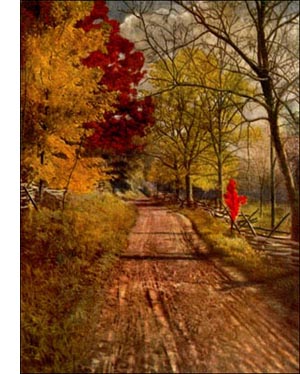Cucumber Tree
 Cucumber Tree (Magnolia acuminata, Linn.) -Pyramidal tree of spreading habit, 60 to 100 feet high, with trunk 3 to 4 feet in diameter. Bark furrowed, thick, coated with brown scales. Wood weak, light, yellowish brown, close grained. Buds silky, pointed, terminal ones longer, larger. Leaves longer than wide, entire, heart-shaped base, acute apex, 6 to 10 inches long, thin, yellow green, sparsely hairy below; yellow in autumn; petioles 1 to 2 inches long. Flowers inconspicuous because yellowish green, bell shaped, terminal, erect, sepals 3, short, reflexed; petals 6 with long, tapering bases; stamens numerous, pistils numerous on central receptacle. Fruit compound, of many coalesced follicles, distorted by abortion of many; seed scarlet, berry-like, hangs out of 2-valved follicle on elastic thread when ripe. Preferred habitat, rocky uplands near streams; low mountain ranges. Distribution, western New York and southern Ontario to Illinois, Kentucky and Arkansas; mountain slopes of Pennsylvania south to Tennessee, Alabama and Mississippi. Uses: Ornamental tree planted in Europe and America to a limited extent. Wood is used for flooring and other general purposes. Good stock upon which to graft less hardy magnolias.
Cucumber Tree (Magnolia acuminata, Linn.) -Pyramidal tree of spreading habit, 60 to 100 feet high, with trunk 3 to 4 feet in diameter. Bark furrowed, thick, coated with brown scales. Wood weak, light, yellowish brown, close grained. Buds silky, pointed, terminal ones longer, larger. Leaves longer than wide, entire, heart-shaped base, acute apex, 6 to 10 inches long, thin, yellow green, sparsely hairy below; yellow in autumn; petioles 1 to 2 inches long. Flowers inconspicuous because yellowish green, bell shaped, terminal, erect, sepals 3, short, reflexed; petals 6 with long, tapering bases; stamens numerous, pistils numerous on central receptacle. Fruit compound, of many coalesced follicles, distorted by abortion of many; seed scarlet, berry-like, hangs out of 2-valved follicle on elastic thread when ripe. Preferred habitat, rocky uplands near streams; low mountain ranges. Distribution, western New York and southern Ontario to Illinois, Kentucky and Arkansas; mountain slopes of Pennsylvania south to Tennessee, Alabama and Mississippi. Uses: Ornamental tree planted in Europe and America to a limited extent. Wood is used for flooring and other general purposes. Good stock upon which to graft less hardy magnolias.The cucumber tree is the hardiest species of native magnolias. Its great leaves betray its sub-tropical affiliations. No tree but the catalpa can match it in the North, and this does not venture by itself farther than the latitude of southern Indiana. Against the foliage mass of oaks and elms and maples the great clean leaves of the cucumber tree form a striking contrast. They are silky at first, but when mature keep only a fringe of hairs on the veins beneath. In autumn the tree turns yellow before the leaves drop. The elevated leaf scars almost encircle the silky winter buds.
Cucumber trees make less show in the period of blossoming than other magnolias. The yellowish-green tulip-like flowers, though large, are scarcely distinguishable at a little distance from the new leaves by which they are surrounded. They are neither beautiful nor pleasantly fragrant. The elongated fruits look like pale green cucumbers at first, but are soon distorted in form by the failure of many of the carpels to set seed. The fleshy green cone flushes pink, and later turns red as autumn approaches. In September each mature carpel splits open and two scarlet seeds hang out, each on an elastic thread. The wind buffets them until they dangle several inches below the conical fruit. Then a gust tears them off, and if they fall in moist leaf mould or on the damp border of a stream, young cucumber trees spring up from this planting.
The cucumber tree is not yet appreciated as a shade and avenue tree in the Northern States. It has few faults and many virtues. It grows vigorously from seed and after transplanting. l he digging and planting must be carefully managed, as the fleshy roots of all magnolias are brittle. Since the tree is comparatively rare in the northern part of its range, nursery stock or seed should be planted rather than stripling trees from the woods.